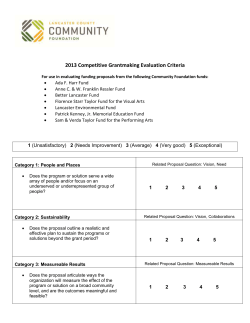
THE USE OF THOMSON REUTERS RESEARCH ANALYTIC RESOURCES IN ACADEMIC PERFORMANCE EVALUATION
THE USE OF THOMSON REUTERS RESEARCH ANALYTIC RESOURCES IN ACADEMIC PERFORMANCE EVALUATION DR. EVANGELIA A.E.C. LIPITAKIS OCTOBER 2014, PRAGUE Thomson Reuters: Solutions Portfolio to Seamlessly Support Research Discover Scholarly Output Benchmark & Analyze Performance Organize References & Write Papers Manage & Report on Scholarly Activity Eugene Garfield’s “Association Of Ideas Index”-1955 Web of Science is the “web” presentation of journal citation indexes developed five decades ago by Dr. Eugene Garfield, founder of ISI (now Thomson Reuters SSR) and an icon in the realm of scholarly information17 Web Of Science Online Citation Database SELECTIVE……YET COMPREHENSIVE • “Multidisciplinary” coverage – enable to analyze the whole context of scientific research • “Multiyear” coverage – enable to analyze the history and development of sciences • “Cover to Cover” policy – enable to follow the flow of a topic regardless of communication type • “ALL Authors, ALL Addresses” – enable to analyze by author name, by institution • “ALL Cited References” – enable to perform analyses on literature that is not indexed Selection Process For The Web Of Science Core Collection Four Points of Evaluation Publishing Standards Editorial Content 12500 selected Journals International Diversity 12000 annual selected conferences Citation Analysis 53000 selected books Applications of Bibliometric Analysis 1. Quantification: • Data reduction (extracting essential information) • Data cleaning and data disambiguation Data Thomson Reuters Expertise & Processing • Web of Science • • • InCites Address unification Data cleansing & standardization Normalization & baselines • For more than four decades Thomson Reuters has provided a wide range of tools and services supporting research evaluation. • Our specialist work with Web of Science data and ensure maximum standardization and unification before delivery to customers. • Not just simple counts and averages, but real metrics founded on baselines for comparison and normalized statistics. Applications of Bibliometric Analysis 2. Measuring: • What can and what should be measured? • What are appropriate measures for the purpose? Productivity and Impact Normalization Top Performance and Scientific Excellence Scientific Collaborations • Fractional Counting • % Open Access • Grants •Self-Citations • Patents • h-index • Citation Impact • Normalized Citation Impact • Normalized Citation Impact – Country Adjusted • Hot Papers • Highly Cited Papers • ESI Most Cited • THE Ranked • % Documents in 1% • % Documents in 10% • Average Percentiles • Average Quartiles • International Collaborations • % International Collaborations •Impact Relative to Country •Impact Relative to Area •Impact Relative to World •Journal Normalized Citation Impact • Research Fronts • Co-citations •Bibliographic Coupling • Baselines • % Industry Collaborations Applications of Bibliometric Analysis 3. Benchmarking • Comparison (like with like) • Putting data into context • Consider limitations Applications of Bibliometric Analysis 4. Presentation and interpretation • Visualizations + interpretation of observations • Linking bibliometric indicators to results of other methods The “SHANGHAI RANKING” National Comparisons – Monitor your Productivity Need to consider the publication practices and fields of research; Do we follow a dominant “quantitative publication” strategy or are we more selective in what and where we publish? InCites - Country Comparison and Normalized Citation Impact Impact shows a constant upward Red Line indicates the World Average Impact trend, which is a good indication of improved research performance InCites – Monitor your International Collaboration • International research collaboration has intensified and is often regarded as an indicator of quality and a way to develop and disseminate scientific knowledge • Funding agencies such as the EC stimulate collaboration within the European Union by applying it as a funding criterion What is the return on international collaboration? How much Czech Republic is collaborating internationally? International collaborations require considerable effort and funding International collaborations are considered to be drivers of impact (citations) International Collaborations - Countries With which countries Czech Republic has produced most collaborations (#of documents)? With which countries Czech Republic has produced most Highly Cited Papers? International Collaborations - Institutions With which institutions Czech Republic has produced most collaborations (#of documents)? With which institutions Czech Republic has produced the most successful collaborations (NCI)? Industry Collaborations – Impact of publications How impactful are Czech Republic publications in collaboration with the industry? In which disciplines are Czech Republic researchers most active? How much Czech Republic researchers collaborate in the disciplines they are most active? Assess your journal strategy in all disciplines with journal ranking indicators Identify in which journals you publish the most.. Institutional Comparisons – Monitor your Productivity How do Czech Republic institutions rank in terms of research output? Institutional Comparisons –Normalized Citation Impact for 2008-2012 How do Czech Republic institutions rank in terms of performance in the fields they publish (NCI)? How does your institution compare with the Global Average ? How does your institution compare with the National Country Average ? At any time you can drill down to article level metrics analysis CURRENTLY APPROXIMATELY 600 INCITES CUSTOMERS WORLDWIDE Selected major InCites customers in Europe: Ministries and Government Agencies Research Institutes and Universities Austria Bulgaria Czech Republic France Greece Hungary Ireland Portugal Romania Russia Slovakia Slovenia Turkey U.K. Max Planck Society Kings College London KTH Royal Institute of Technology Russian Academy of Sciences University of Geneva Utrecht University University of Oslo STRONG BRAND Catholic University in Leuven University of Helsinki University of Barcelona University of Vienna Masaryk University Brno University of West Bohemia Pilsen IPN Methodology Project THANK YOU!
© Copyright 2025




















